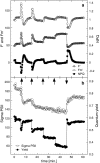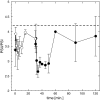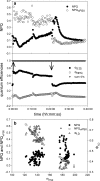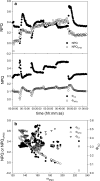Photoacclimation in Dunaliella tertiolecta reveals a unique NPQ pattern upon exposure to irradiance
- PMID: 22101577
- PMCID: PMC3224225
- DOI: 10.1007/s11120-011-9709-2
Photoacclimation in Dunaliella tertiolecta reveals a unique NPQ pattern upon exposure to irradiance
Abstract
Highly time-resolved photoacclimation patterns of the chlorophyte microalga Dunaliella tertiolecta during exposure to an off-on-off (block) light pattern of saturating photon flux, and to a regime of consecutive increasing light intensities are presented. Non-photochemical quenching (NPQ) mechanisms unexpectedly responded with an initial decrease during dark-light transitions. NPQ values started to rise after light exposure of approximately 4 min. State-transitions, measured as a change of PSII:PSI fluorescence emission at 77 K, did not contribute to early NPQ oscillations. Addition of the uncoupler CCCP, however, caused a rapid increase in fluorescence and showed the significance of qE for NPQ. Partitioning of the quantum efficiencies showed that constitutive NPQ was (a) higher than qE-driven NPQ and (b) responded to light treatment within seconds, suggesting an active role of constitutive NPQ in variable energy dissipation, although it is thought to contribute statically to NPQ. The PSII connectivity parameter p correlated well with F', F(m)' and NPQ during the early phase of the dark-light transients in sub-saturating light, suggesting a plastic energy distribution pattern within energetically connected PSII centres. In consecutive increasing photon flux experiments, correlations were weaker during the second light increment. Changes in connectivity can present an early photoresponse that are reflected in fluorescence signals and NPQ and might be responsive to the short-term acclimation state, and/or to the actinic photon flux.
© The Author(s) 2011. This article is published with open access at Springerlink.com
Figures









Similar articles
-
Seasonal acclimation of photosystem II in Pinus sylvestris. I. Estimating the rate constants of sustained thermal energy dissipation and photochemistry.Tree Physiol. 2008 Oct;28(10):1475-82. doi: 10.1093/treephys/28.10.1475. Tree Physiol. 2008. PMID: 18708329
-
Acclimation of tobacco leaves to high light intensity drives the plastoquinone oxidation system--relationship among the fraction of open PSII centers, non-photochemical quenching of Chl fluorescence and the maximum quantum yield of PSII in the dark.Plant Cell Physiol. 2009 Apr;50(4):730-43. doi: 10.1093/pcp/pcp032. Epub 2009 Feb 27. Plant Cell Physiol. 2009. PMID: 19251745
-
Photosystem II antennae are not energetically connected: evidence based on flash-induced O2 evolution and chlorophyll fluorescence in sunflower leaves.Photosynth Res. 2012 Oct;114(1):15-28. doi: 10.1007/s11120-012-9775-0. Epub 2012 Aug 14. Photosynth Res. 2012. PMID: 22890327
-
Nonphotochemical Chlorophyll Fluorescence Quenching: Mechanism and Effectiveness in Protecting Plants from Photodamage.Plant Physiol. 2016 Apr;170(4):1903-16. doi: 10.1104/pp.15.01935. Epub 2016 Feb 10. Plant Physiol. 2016. PMID: 26864015 Free PMC article. Review.
-
Light energy allocation at PSII under field light conditions: how much energy is lost in NPQ-associated dissipation?Plant Physiol Biochem. 2014 Aug;81:115-20. doi: 10.1016/j.plaphy.2014.03.018. Epub 2014 Mar 27. Plant Physiol Biochem. 2014. PMID: 24726274 Review.
Cited by
-
Using Phenomic Analysis of Photosynthetic Function for Abiotic Stress Response Gene Discovery.Arabidopsis Book. 2016 Sep 9;14:e0185. doi: 10.1199/tab.0185. eCollection 2016. Arabidopsis Book. 2016. PMID: 27695390 Free PMC article.
-
Exploring Variability of Trichodesmium Photophysiology Using Multi-Excitation Wavelength Fast Repetition Rate Fluorometry.Front Microbiol. 2022 Apr 8;13:813573. doi: 10.3389/fmicb.2022.813573. eCollection 2022. Front Microbiol. 2022. PMID: 35464918 Free PMC article.
-
State-transitions facilitate robust quantum yields and cause an over-estimation of electron transport in Dunaliella tertiolecta cells held at the CO₂ compensation point and re-supplied with DIC.Photosynth Res. 2014 Mar;119(3):257-72. doi: 10.1007/s11120-013-9937-8. Epub 2013 Oct 18. Photosynth Res. 2014. PMID: 24135997
References
-
- Adams WW, Demmig-Adams B. The xanthophyll cycle and sustained thermal energy dissipation activity in Vinca minor and Euonymus kiaufschovicus in winter. Plant Cell Environ. 1995;18(2):117–127.
-
- Adams WW, Demming-Adams B, Verhoeven AS, Barker D. Photoinhibition during winter stress-involvement of sustained xanthophyll cycle-dependent energy dissipation. Aust J Plant Physiol. 1995;22:261–276.
-
- Ahn TK, Avenson TJ, Peers G, Li Z, Dall’osto L, Bassi R, Niyogi KK, Fleming GR. Investigating energy partitioning during photosynthesis using an expanded quantum yield convention. Chem Phys. 2009;357(13):151–158.
Publication types
MeSH terms
Substances
LinkOut - more resources
Full Text Sources

